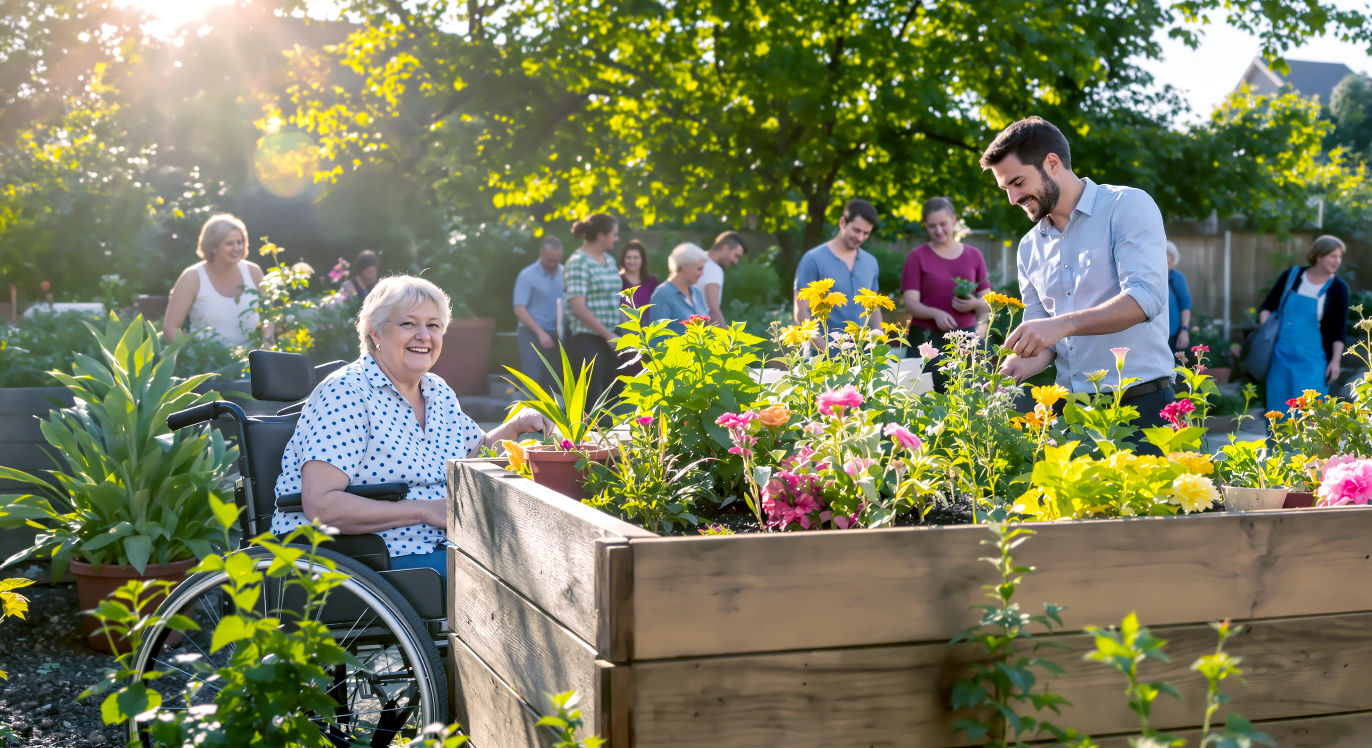Horticultural Therapy: Guide to the Healing Power of Gardens in the UK
The definitive guide to horticultural therapy in the UK. Explore its history, the science behind it, who it helps, and how you can get involved.

This post may contain affiliate links. If you make a purchase through these links, we may earn a commission at no additional cost to you.
There’s a special kind of magic that happens when your hands are in the soil. It’s a quiet, grounding feeling that most of us have felt, even if it’s just potting a few herbs on a windowsill. It’s the simple satisfaction of watching a tiny seed you planted push its way through the earth, or the calming scent of lavender on a warm summer’s evening. We often think of this as a hobby—a pleasant way to pass the time. But what if it was something more? What if the simple act of gardening could be a powerful, life-changing therapy?
Welcome to the world of Horticultural Therapy, a practice that harnesses this very magic to heal and support people facing all kinds of challenges. It’s not just about having green fingers; it’s about using gardens and nature to help people grow.
In the UK, this field is often called Social and Therapeutic Horticulture (STH). It’s a formal, goal-oriented practice guided by trained professionals to improve mental and physical health. From helping someone recover from a serious illness to offering a sense of purpose to those feeling lost, STH is quietly transforming lives in community gardens, hospitals, and allotments across Britain.
This article is your definitive guide. We’ll dig deep into what horticultural therapy really is, uncover its surprising history, and explore the science that proves why it works so well. We’ll look at who it helps, see what it looks like in practice here in the UK, and show you how you can get involved, whether you have a sprawling garden or just a small, sunny spot. So, grab a cuppa, get comfortable, and let’s explore the incredible healing power of gardens.
What Exactly is Horticultural Therapy? Unearthing the Meaning
Before we go any further, it’s important to understand what makes horticultural therapy different from just enjoying a bit of gardening. While any time spent in nature is good for you, STH is a much more structured and purposeful process.
It’s Not Just a Bit of Weeding
Think of it this way: anyone can kick a football around in the park for fun, but a professional footballer follows a specific training plan with a coach to improve their performance. It’s the same with gardening. Enjoying your allotment on a Sunday afternoon is fantastic for your wellbeing, but it isn’t horticultural therapy.
Horticultural Therapy (or STH) is a planned treatment programme that uses gardening and plants to help people with specific health goals. It’s always led by a trained therapist who understands both horticulture (the art of gardening) and health and social care. They work with individuals or small groups to create a programme tailored to their specific needs.
For one person, the goal might be to improve their physical strength and coordination after an accident. For another, it could be about reducing anxiety and building the confidence to be around other people again. The garden becomes a safe, living space where people can work towards these goals without pressure.
The Key Ingredients: People, Plants, and Purpose
So, what are the essential parts that make STH work? There are four main ingredients:
- A Trained Professional: The horticultural therapist is the key. They know how to match the right gardening activity to the person’s needs. They create a safe and supportive environment and help people get the most out of their time in the garden.
- The Person (or Client): The therapy is completely centred around the individual and their personal goals. It’s not about creating a perfect, Chelsea Flower Show-worthy garden; it’s about the person’s journey.
- The Garden Environment: The garden itself is a crucial part of the therapy. It’s a calm, non-threatening space that’s full of life and sensory experiences—the smell of damp earth, the sound of birds, the feeling of a leaf. Therapeutic gardens are often designed to be accessible, with things like raised beds for wheelchair users and easy-grip tools.
- The Gardening Activities: The tasks themselves are the tools of the therapy. Sowing tiny seeds can help develop fine motor skills. Digging a new bed can be a healthy outlet for frustration. Watering plants teaches responsibility and nurturing. Harvesting vegetables provides a wonderful sense of achievement.
It’s the combination of these four things that makes horticultural therapy so powerful. It’s a living, breathing therapy that changes with the seasons, just like the people and plants within it.
A Potted History: How Did Gardening Become a Therapy?
The idea that nature is good for us is nothing new. In fact, it’s an idea that’s been around for thousands of years. But the journey from that general feeling to a formal, recognised therapy has been a long and fascinating one.
Ancient Roots and Victorian Reformers
As far back as ancient Egypt, physicians were prescribing walks in the palace gardens for royalty who were feeling unwell. The ancient Persians even created beautiful, calming gardens specifically designed to please the senses and soothe the mind.
The idea really started to take root in a more scientific way in the 18th century with Dr. Benjamin Rush, a man often called the ‘Father of American Psychiatry’. He was one of the first to formally document the positive effects that gardening had on his patients with mental illness, noting that digging in the soil seemed to help them recover.
Here in the UK, the concept gained ground during the Victorian era. At a time when asylums were often grim, forbidding places, some reformers pushed for a new approach called ‘moral treatment’. They believed that patients would get better faster if they were treated with kindness and given meaningful activities to do in a pleasant environment. Many forward-thinking hospitals built gardens and greenhouses, where patients could work and find a sense of peace and purpose away from the crowded wards.
From Post-War Recovery to Modern Practice
The real turning point for horticultural therapy in Britain came after the First and Second World Wars. Thousands of servicemen returned home with life-changing physical injuries and deep psychological scars, what we now call PTSD.
Gardening was introduced as a key part of their rehabilitation. It offered gentle physical exercise that helped rebuild damaged bodies, but just as importantly, it gave them a quiet, hopeful focus away from the horrors they had experienced. Nurturing new life in the soil was a powerful antidote to the destruction of war. The famous motto of the Ex-Service Fellowship Centres was “Talks, Walks, and Squashes,” highlighting the central role of the allotment.
This success laid the groundwork for the modern profession. In 1978, a pioneering charity called the Society for Horticultural Therapy was founded, which we now know as Thrive. This was a huge step forward. Thrive began to formally research the benefits of gardening, develop training programmes for therapists, and champion STH as a credible form of treatment. Thanks to the work of organisations like Thrive, horticultural therapy has grown from a good idea into a respected profession that helps thousands of people across the UK today.
The Science Bit: How Does Mucking About in a Garden Actually Help?
It all sounds lovely, but what’s actually going on in our brains and bodies when we’re gardening? It turns out there’s some fascinating science that explains why horticultural therapy is so effective.
Your Brain on Nature
Our connection to the natural world is deeper than you might think. We’ve spent hundreds of thousands of years living in nature, and only a tiny fraction of that time in cities and offices. Scientists have a name for our innate, biological need to connect with nature: the Biophilia Hypothesis. It suggests that we are hard-wired to feel good in natural environments. A garden, even a small one, is a direct link to that world.
This connection has a real, measurable effect on our stress levels. Numerous studies have shown that spending time in a green space can significantly lower our levels of cortisol, the body’s main stress hormone. Your heart rate slows, your blood pressure drops, and you start to feel calmer.
There’s also something called Attention Restoration Theory. Our modern lives require a lot of ‘directed attention’—the kind of intense focus you need to answer emails, drive in traffic, or scroll through social media. This is mentally draining. Nature, on the other hand, engages us in a gentle, effortless way that scientists call ‘soft fascination’. Watching a bee buzz from flower to flower or seeing the leaves rustle in the wind allows your brain’s ‘directed attention’ muscle to rest and recover. It’s like a charger for a tired mind.
Good for the Body, Good for the Soul
The benefits don’t stop with the brain. Horticultural therapy is brilliant for the body, too.
- Physical Benefits: Gardening is a form of gentle, whole-body exercise. It gets you moving and stretching without the pressure of a gym. Activities like digging, raking, and carrying a watering can improve muscle strength and stamina. Fiddly tasks like sowing seeds or transplanting seedlings are brilliant for improving fine motor skills and hand-eye coordination, which is especially helpful for people recovering from a stroke or injury.
- Psychological Benefits: This is where STH truly shines. Nurturing a plant from seed to maturity provides an incredible sense of purpose and achievement. In a world that can feel chaotic, the predictable cycles of the garden—sowing, growing, harvesting, and resting—are deeply reassuring. It also teaches patience and resilience. Not every seed will sprout, and some plants will get eaten by slugs—and that’s okay. It’s a gentle lesson in letting go of perfectionism. Gardening is also a naturally mindful activity. When you’re focused on the feeling of the soil or the smell of a tomato plant, it’s hard to worry about the past or the future. You are simply in the present moment.
- Social Benefits: For many people, loneliness is a huge problem. STH projects are often run in small groups, providing a safe, relaxed way to connect with others. You don’t have to make awkward small talk; you can just work alongside someone, sharing a task. It’s a fantastic way to reduce isolation and build a sense of community. Friendships are formed over seed trays and wheelbarrows, creating vital support networks that last long after the session has ended.
Who Can Benefit? A Garden for Everyone
One of the most wonderful things about horticultural therapy is that it can be adapted to help almost anyone. The garden is a great leveller; it doesn’t care about your diagnosis, your background, or your age. It simply offers a space to grow.
Supporting Mental Wellbeing
Gardening has become a cornerstone of ‘green’ or ‘eco’ therapy for a reason. For people struggling with anxiety, depression, and stress, the garden offers a sanctuary. The gentle routine of caring for plants can provide a sense of stability when everything else feels overwhelming. The physical work is a great way to burn off anxious energy, and the tangible results—a blooming flower or a ripe strawberry—are a powerful reminder that your efforts matter. For veterans and others living with PTSD, the garden can be a safe space where they are in control, helping them to feel grounded and secure.
Healing for Physical and Learning Disabilities
Therapeutic gardens are cleverly designed to be accessible to everyone. Raised beds and vertical planters mean that wheelchair users can get involved without having to bend down. Specially adapted long-handled or ergonomic tools can help people with limited strength or grip. For people recovering from a stroke or a brain injury, the repetitive, gentle movements of gardening can be a key part of their physical rehabilitation.
It’s also hugely beneficial for people with learning disabilities, offering a way to learn practical skills, improve communication, and build confidence in a supportive, non-judgemental setting. One of the most inspiring examples in the UK is Horatio’s Garden, a charity that builds and runs beautiful, accessible gardens in NHS spinal injury centres, offering a vital space for rehabilitation and hope.
A Ray of Sunshine for Dementia and the Elderly
For older people, especially those living with dementia, a garden can be a magical place. Sensory gardens are often designed to stimulate the senses, with fragrant herbs like rosemary and mint, soft, furry leaves like lamb’s ear, and the gentle sound of rustling grasses or a water feature. These sensory triggers can unlock memories and spark conversations, a practice known as reminiscence therapy. The simple act of deadheading a rose or picking a tomato can help reduce agitation, improve mood, and provide a connection to a much-loved past hobby.
Sowing Seeds of Change in Other Areas
The reach of horticultural therapy doesn’t stop there. It’s used with great success in:
- Prisons: Gardening projects, like those run by The Clink Charity, teach prisoners new skills, a sense of responsibility, and a way to work collaboratively, which can significantly reduce reoffending.
- Addiction Recovery: Caring for plants helps people in recovery to develop nurturing skills and provides a healthy, positive focus during a difficult time.
- Children with Special Needs: School gardens are fantastic for helping children with behavioural or learning difficulties. It improves their focus, teaches them about science and nature, and encourages them to try healthy food they’ve grown themselves.
Horticultural Therapy in the UK Today: A Growing Movement
Once a niche practice, STH is now becoming a much more recognised and respected part of the UK’s health and social care landscape. It’s part of a wider shift towards understanding that health is about more than just medicine; it’s about community, purpose, and our connection to the world around us.
On the NHS: Social Prescribing
One of the biggest developments in recent years has been the rise of social prescribing. This is a brilliant initiative where GPs and other health professionals can ‘prescribe’ non-medical treatments to their patients. Instead of just giving them a pill, a doctor might refer someone to a local walking group, an art class, or, increasingly, a community gardening project.
This is a game-changer. It means the NHS is formally recognising that activities like therapeutic horticulture can be just as important for someone’s health as traditional medicine, especially for issues like loneliness, mild depression, and long-term health management. It’s a holistic approach that empowers people to take an active role in their own wellbeing.
The Charity Champions: Thrive, Mind, and the RHS
The growth of STH in the UK wouldn’t have been possible without the tireless work of several key charities.
- Thrive is the national charity for social and therapeutic horticulture. They are the experts, running their own therapeutic programmes, providing training for therapists, and conducting vital research to prove the benefits of the practice.
- Mind, the mental health charity, has long championed ecotherapy through projects like its ‘Ecominds’ scheme, funding and supporting community gardens and other nature-based activities across the country.
- The Royal Horticultural Society (RHS) is also a major supporter. Through their ‘Community Gardens’ and ‘Wellbeing Gardens’ programmes, they help bring the healing power of plants to schools, hospitals, and neighbourhoods up and down the country.
From City Allotments to Hospital Gardens
Today, you can find STH projects in all sorts of places. There are vibrant community gardens on reclaimed land in the heart of our biggest cities, providing a green oasis and a social hub for local residents. You’ll find peaceful therapeutic gardens tucked away in hospitals and hospices, offering a quiet escape for patients and their families. And, of course, there’s the humble allotment, a cornerstone of British culture that has become a vital space for many therapeutic horticulture groups.
What Happens in a Session? A Look Inside the Potting Shed
So, what does horticultural therapy actually look like from week to week? While every session is different, they all follow a gentle, person-centred structure.
It All Starts with a Plan
When someone joins a project, they don’t just get handed a spade and told to get digging. A therapist will have a chat with them first to understand their situation, their strengths, their challenges, and what they hope to get out of the experience. Together, they will set a few simple, achievable goals. For someone with social anxiety, a first step might just be to feel comfortable being in the garden with one other person for twenty minutes. For someone recovering from a stroke, a goal might be to successfully pot on ten seedlings using their weaker hand.
A Year in the Garden
The activities naturally follow the rhythm of the seasons, which provides a wonderful sense of structure and hope.
- Spring is all about new beginnings. Sessions focus on sowing seeds and pricking out delicate seedlings. It’s a time of gentle, careful work that represents hope and potential for the year ahead.
- Summer is a time of nurturing and growth. There’s watering to be done, weeds to be pulled, and plants to be supported with canes. It teaches patience and the rewards of consistent care. The garden is buzzing with life, and the sensory experience is at its peak.
- Autumn brings the satisfaction of the harvest. Picking apples, digging up potatoes, and collecting seeds for next year provide a powerful, tangible sense of achievement. It’s a time for celebrating success and understanding the natural cycles of life and renewal.
- Winter is a quieter, more reflective time. The work moves indoors to cleaning and sharpening tools, planning the garden for next year, or making festive wreaths from evergreen cuttings. It’s a time for rest, reflection, and preparation for the return of spring.
More Than Just Gardening
A good STH programme includes a variety of activities to keep things interesting and cater to different abilities and moods. A session might include a spot of wildlife watching, building a bug hotel, doing some garden-related crafts, or even cooking a simple meal with the vegetables that the group has grown. The social element is key, with time for a cup of tea and a chat often being just as therapeutic as the gardening itself.
How to Get Involved: Your Path to the Garden
Feeling inspired? The good news is that there are many ways to connect with the healing power of gardening, whether you want to join a project, create your own therapeutic space at home, or even train to become a therapist yourself.
Finding a Project Near You
If you think you or someone you know could benefit from joining an STH project, here are the best places to start:
- Talk to your GP: Ask them about social prescribing in your area. They should know what local projects are available and can make a referral for you.
- Contact Thrive: As the national charity, their website is a goldmine of information. They have a ‘Find a Garden Project’ tool to help you locate services near you.
- Look for local community gardens and allotments: A quick search online for “community garden near me” will often reveal fantastic local projects. While not all will offer formal therapy, they are a great way to experience the social and wellbeing benefits of gardening.
Creating Your Own Healing Haven at Home
You don’t need a huge garden to feel the benefits. You can create your own little patch of therapeutic greenness almost anywhere.
- Start small: Don’t overwhelm yourself. A few pots on a balcony or a window box is a perfect place to begin. Choose easy-to-grow plants like salad leaves, herbs, or marigolds.
- Focus on the senses: Pick plants that you love to touch, smell, and look at. Lavender, rosemary, mint, and thyme are wonderfully fragrant and easy to care for. Soft-leaved plants like Stachys (lamb’s ear) are lovely to touch.
- Create a place to sit: The most important part of a therapeutic garden is a place where you can simply stop and ‘be’. Make sure you have a comfortable chair where you can sit and watch the bees, listen to the birds, or just enjoy a moment of peace.
- Try mindful gardening: The next time you are watering your plants or pulling up a weed, try to do it mindfully. Pay full attention to what you’re doing. Notice the weight of the watering can, the sound of the water, the feel of the soil. It’s a simple but powerful way to calm a busy mind.
Becoming a Horticultural Therapist
If you have a passion for both gardening and helping people, a career in horticultural therapy could be incredibly rewarding. The main training and qualifications in the UK are overseen by Thrive. You can find out more about their courses and the different pathways into the profession on their website.
Conclusion: The Enduring Power of the Garden
In our fast-paced, digital world, it’s easier than ever to feel disconnected—from each other, from the natural world, and from ourselves. Horticultural therapy offers a simple, powerful antidote. It reminds us of something ancient and intuitive: that we are part of nature, and in caring for it, we can also learn to care for ourselves.
It’s a therapy that doesn’t require difficult conversations or complex technology. Instead, it offers a spade, a seed, and a safe space to grow. It’s a collaboration between people, plants, and the quiet, steady rhythm of the seasons. Whether it’s in a state-of-the-art hospital garden or a simple pot on a windowsill, the message is the same: growth is always possible.
Further Reading
For more information, support, or to find a project near you, please visit these highly respected organisations:
- Thrive: The national charity for social and therapeutic horticulture. The best resource for information, training, and finding projects. www.thrive.org.uk
- RHS Gardening: The Royal Horticultural Society offers extensive advice on gardening for wellbeing and supports community garden projects. https://www.rhs.org.uk/advice/health-and-wellbeing
- Mind: The mental health charity provides information on ecotherapy, including gardening. https://www.mind.org.uk/information-support/drugs-and-treatments/talking-therapy-and-counselling/ecotherapy/
- Horatio’s Garden: This inspirational charity creates and nurtures beautiful, accessible gardens in NHS spinal injury centres. www.horatiosgarden.org.uk






